Role of Law, Position of Actor and Linkage of Policy in China’s National Environmental Governance System, 1972–2016
Abstract
:1. Introduction
2. China’s National Environmental Governance System
2.1. Environmental Laws
2.2. Environmental Policy Instruments
- (1) Regulatory policy instruments
- (2) Market-based policy instruments
- (3) Voluntary policy instruments
- (4) Macro-level guiding policy instruments
2.3. Actors Involved in Environmental Governance
3. Materials and Methods
4. Results
4.1. Laws Create Windows of Opportunity for Policy Generation
4.2. Policies Activate Actors and Demarcate Issues
4.3. Actors and Issues Build Intentional and Emergent Bridges between Policies
5. Conclusions
Supplementary Materials
Acknowledgments
Conflicts of Interest
References
- Guo, X.; Marinova, D.; Hong, J. China’s shifting policies towards sustainability: A low carbon economy and environmental protection. J. Contemp. China 2013, 81, 428–445. [Google Scholar] [CrossRef]
- Holdaway, J. Environment and health in China: An introduction to an emerging research field. J. Contemp. China 2010, 63, 1–22. [Google Scholar] [CrossRef]
- Liu, J.; Diamond, J. China’s environment in a globalizing world. Nature 2005, 435, 1179–1186. [Google Scholar] [CrossRef] [PubMed]
- Huang, X.; Zhao, D.; Brown, G.C.; Wu, Y.; Waldron, S.A. Environmental issues and policy priorities in China: A content analysis of government documents. China Int. J. 2010, 2, 220–246. [Google Scholar] [CrossRef]
- Lotspeich, R.; Chen, A. Environmental protection in the People’s Republic of China. J. Contemp. China 2007, 14, 33–59. [Google Scholar] [CrossRef]
- China National People’s Congress. China Environmental Status Report; Ministry of Environmental Protection: Beijing, China, 2016. [Google Scholar]
- Janicke, M. The multi-level system of global climate governance—The model and its current state. Environ. Policy Gov. 2017, 27, 108–121. [Google Scholar] [CrossRef]
- Ruhl, J.B.; Katz, D.M.; Bommariota, M.J., II. Harnessing legal complexity. Science 2017, 355, 1377–1378. [Google Scholar] [CrossRef] [PubMed]
- Chapman, M.; Klassen, S.; Kreitzman, M.; Semmelink, A.; Sharp, K.; Singh, G.; Chan, M.A. 5 key challenges and solutions for governing complex adaptive (food) systems. Sustainability 2017, 9, 1594. [Google Scholar] [CrossRef]
- Rivera, J.; Oh, C.H. Environmental regulations and multinational corporations’ foreign market entry investments. Policy Stud. J. 2013, 41, 243–272. [Google Scholar] [CrossRef]
- Paavola, J. Institutions and environmental governance: A reconceptualization. Ecol. Econ. 2007, 63, 93–103. [Google Scholar] [CrossRef]
- McAllister, L.K. Making Law Matter: Environmental Protection and Legal Institutions in Brazil; Stanford University Press: Stanford, CA, USA, 2008. [Google Scholar]
- Keast, R.; Mandell, M.; Brown, K. Mixing state, market, and network governance modes: The role of government in “crowded” policy domains. Int. J. Organ. Theory Behav. 2006, 9, 27–50. [Google Scholar] [CrossRef]
- Lo, C.W.-H. Environmental management by law in China: The Guangzhou experience. J. Contemp. China 2007, 6, 39–58. [Google Scholar] [CrossRef]
- Niles, M.T.; Lubell, M. Integrative frontiers in environmental policy theory and research. Policy Stud. J. 2012, 40, 41–64. [Google Scholar] [CrossRef]
- Chen, S. Energy, Environment and Economic Transformation in China; Routledge: New York, NY, USA, 2015. [Google Scholar]
- Lo, C.W.-H.; Tang, S.-Y. Institutions, Regulatory Styles, Society and Environmental Governance in China; Routledge: New York, NY, USA, 2013. [Google Scholar]
- Carter, N.; Mol, A.P.J. Environmental Governance in China; Routledge: New York, NY, USA, 2007. [Google Scholar]
- Golub, J. The new instruments for environmental policy in EU: Introduction and overview. In New Policy Instruments for Environmental Policy in Europe; Golub, J., Ed.; Routledge: London, UK, 1998. [Google Scholar]
- Collier, U. Sustainability, subsidiarity and deregulation: New directions in EU environmental policy. Environ. Politics 1997, 6, 1–23. [Google Scholar] [CrossRef]
- Rittberge, B.; Richardson, J. Old wine in new bottles? The commission and the use of environmental policy instruments. Public Adm. 2003, 81, 575–606. [Google Scholar] [CrossRef]
- Fiorino, D.J. The New Environmental Regulation; MIT Press: Cambridge, MA, USA, 2006. [Google Scholar]
- Douglas, W. Market-based instruments in Germany and the Netherlands: A case of comparison versus cooperation. Environ. Policy Gov. 1995, 1, 1–6. [Google Scholar]
- Klassert, C.; Mockel, S. Improving the policy mix: The scope for market-based instruments in EU biodiversity policy. Environ. Policy Gov. 2013, 5, 311–322. [Google Scholar] [CrossRef]
- Liao, Z.J. Environmental policy instruments, environmental innovation and the reputation of enterprises. J. Clean. Prod. 2018, 171, 1111–1117. [Google Scholar] [CrossRef]
- Daley, D.M. Voluntary approaches to environmental problems: Exploring the rise of nontraditional public policy. Policy Stud. J. 2007, 35, 165–180. [Google Scholar] [CrossRef]
- Brouhle, K.; Griffiths, C.; Wolverton, A. Evaluating the role of EPA policy levers: An examination of a voluntary program and regulatory threat in the metal-finishing industry. J. Environ. Econ. Manag. 2009, 57, 166–181. [Google Scholar] [CrossRef]
- Tsang, S.; Kolk, A. The evolution of Chinese policies and governance structures on environment, energy and climate. Environ. Policy Gov. 2010, 20, 180–196. [Google Scholar] [CrossRef]
- Abbott, A.; Tsay, A. Sequence analysis and optimal matching methods in sociology. Sociol. Methods Res. 2000, 29, 3–33. [Google Scholar] [CrossRef]
- Abell, P. The Syntax of Social Life: The Theory and Methods of Comparative Narratives; Clarendon Press: Oxford, UK, 1987. [Google Scholar]
- Poole, M.S.; van de Ven, A.H.; Dooley, K.; Holmes, M.E. Organizational Change and Innovation Processes: Theory and Methods for Research; Oxford University Press: New York, NY, USA, 2000. [Google Scholar]
- Diggle, P.; Heagerty, P.; Liang, K.Y.; Zeger, S. Analysis of Longitudinal Data; Oxford University Press: Oxford, UK, 2002. [Google Scholar]
- Spekkink, W.A.H.; Boons, F.A.A. The emergence of collaborations. J. Public Adm. Res. Theory 2016, 26, 613–630. [Google Scholar] [CrossRef]
- Cosens, B.A.; Craig, R.K.; Hirsch, S.L.; Arnold, C.A.; Benson, M.H.; DeCaro, D.A.; Garmestani, A.S.; Gosnell, H.; Ruhl, J.; Schlager, E. The role of law in adaptive governance. Ecol. Soc. 2017, 22, 30. [Google Scholar] [CrossRef]
- Kingdon, J.W. Agendas, Alternatives, and Public Policies; Harper Collins: New York, NY, USA, 1995. [Google Scholar]
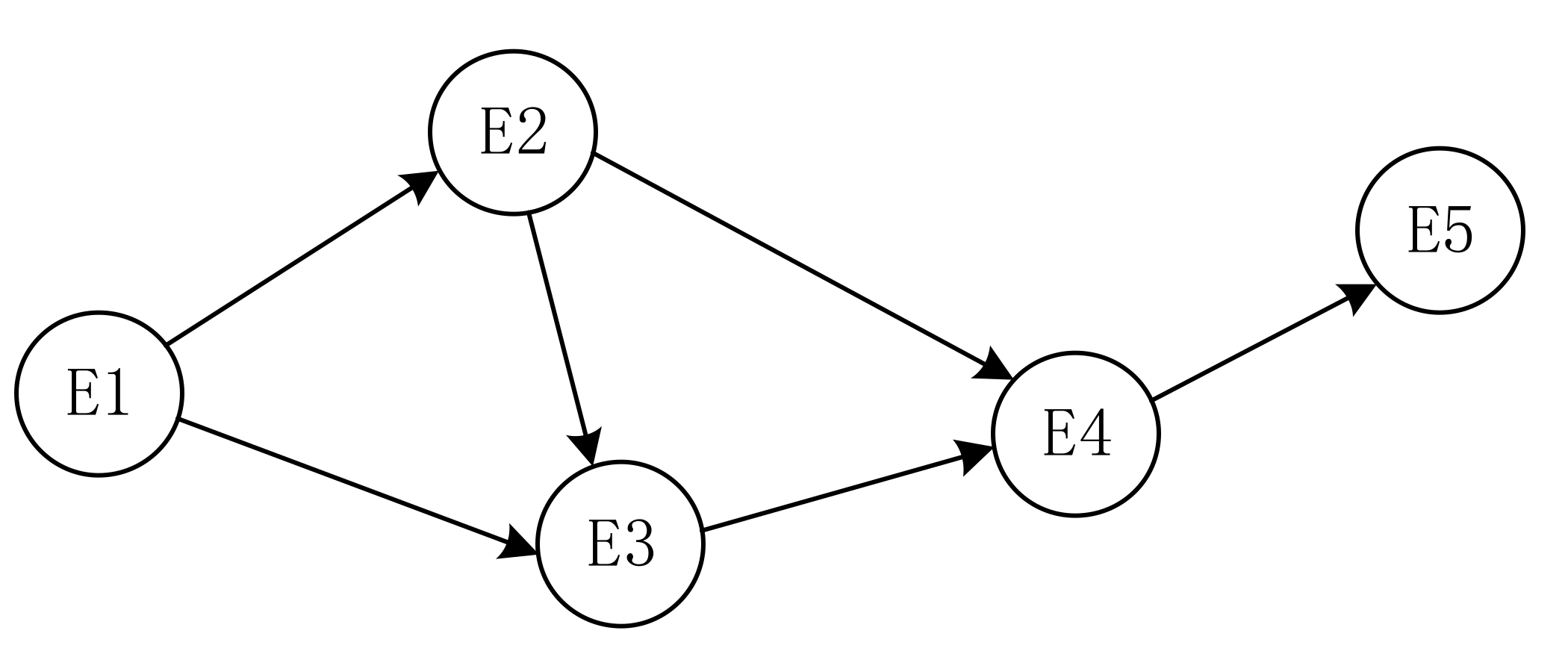
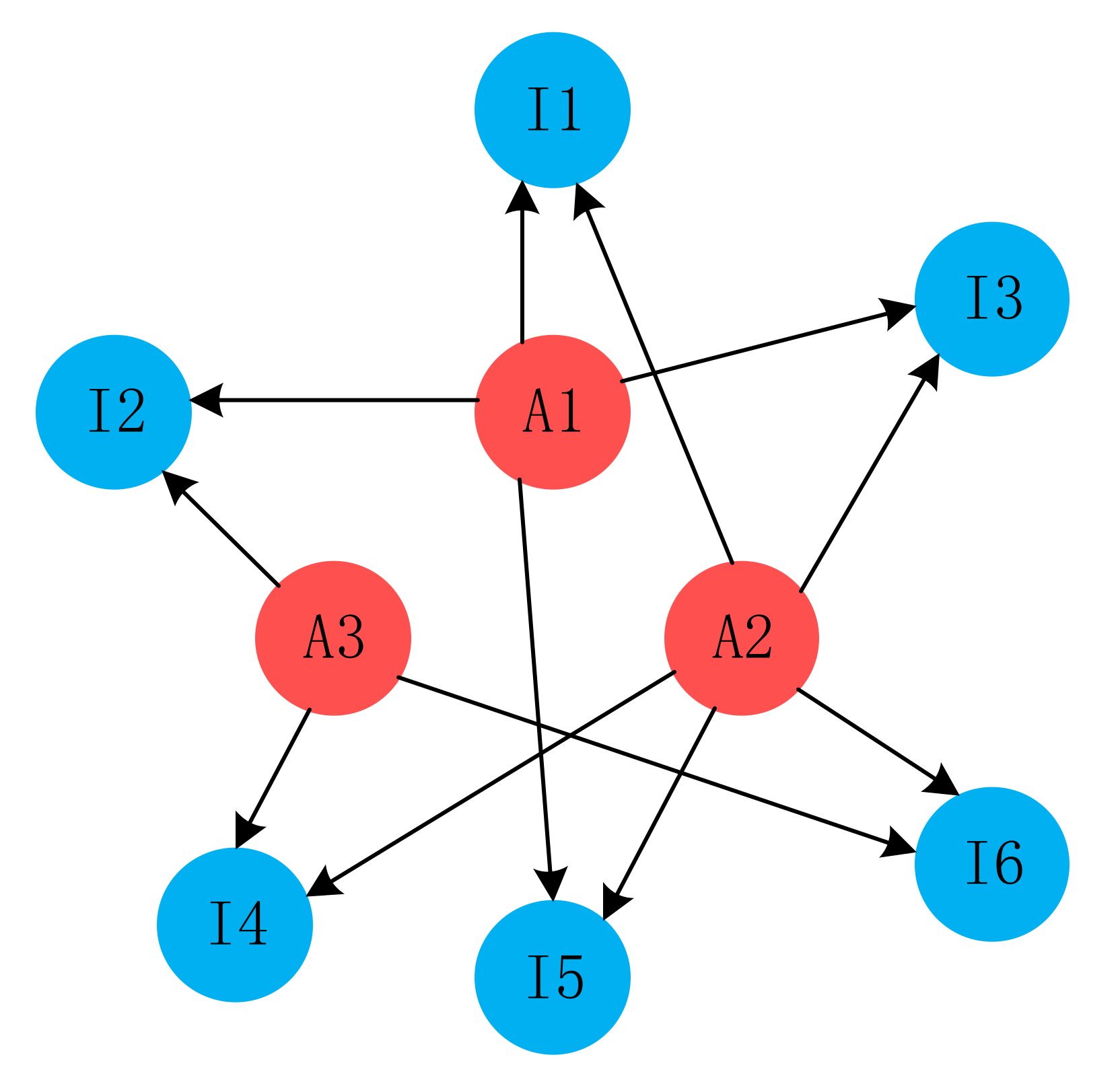
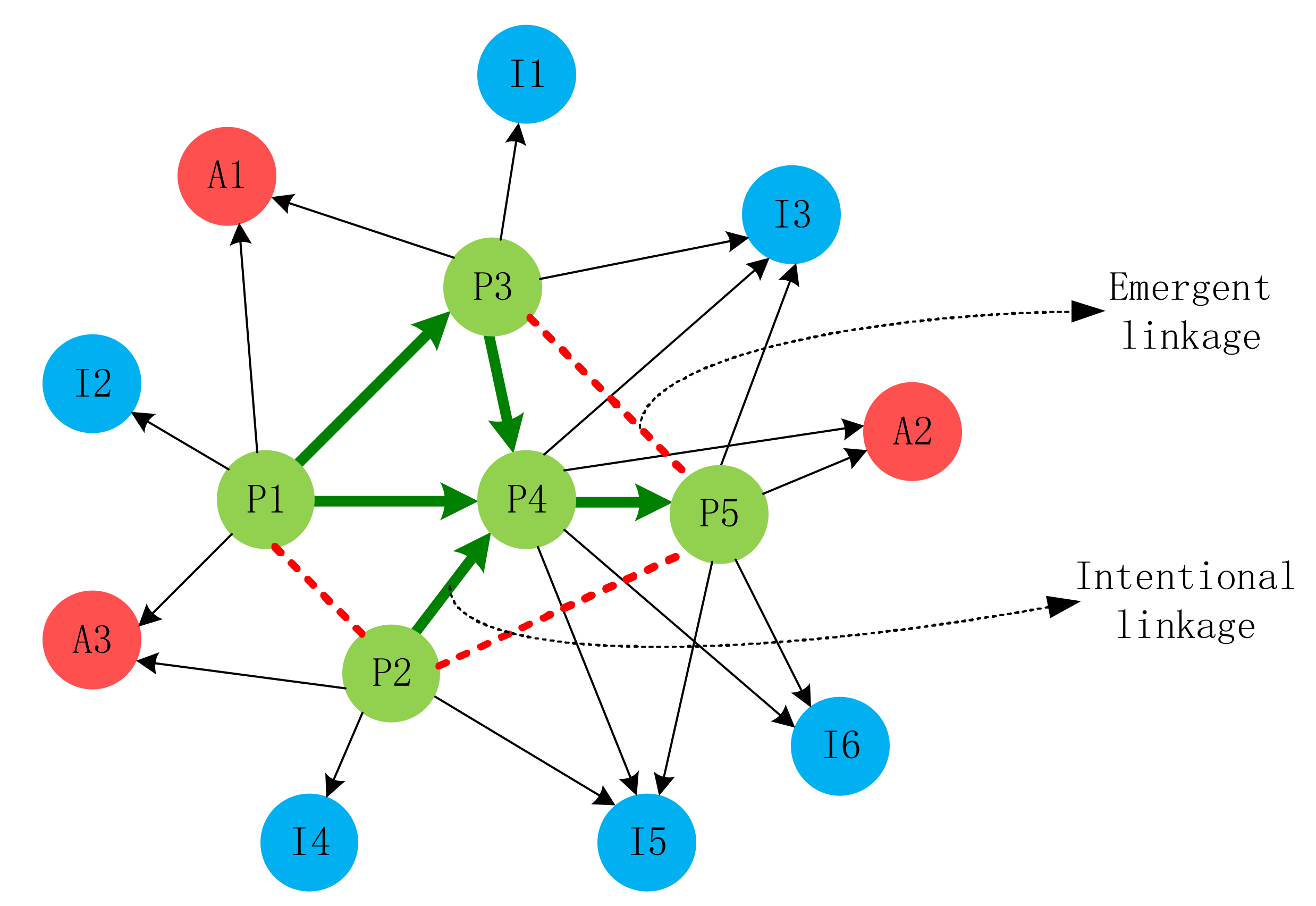
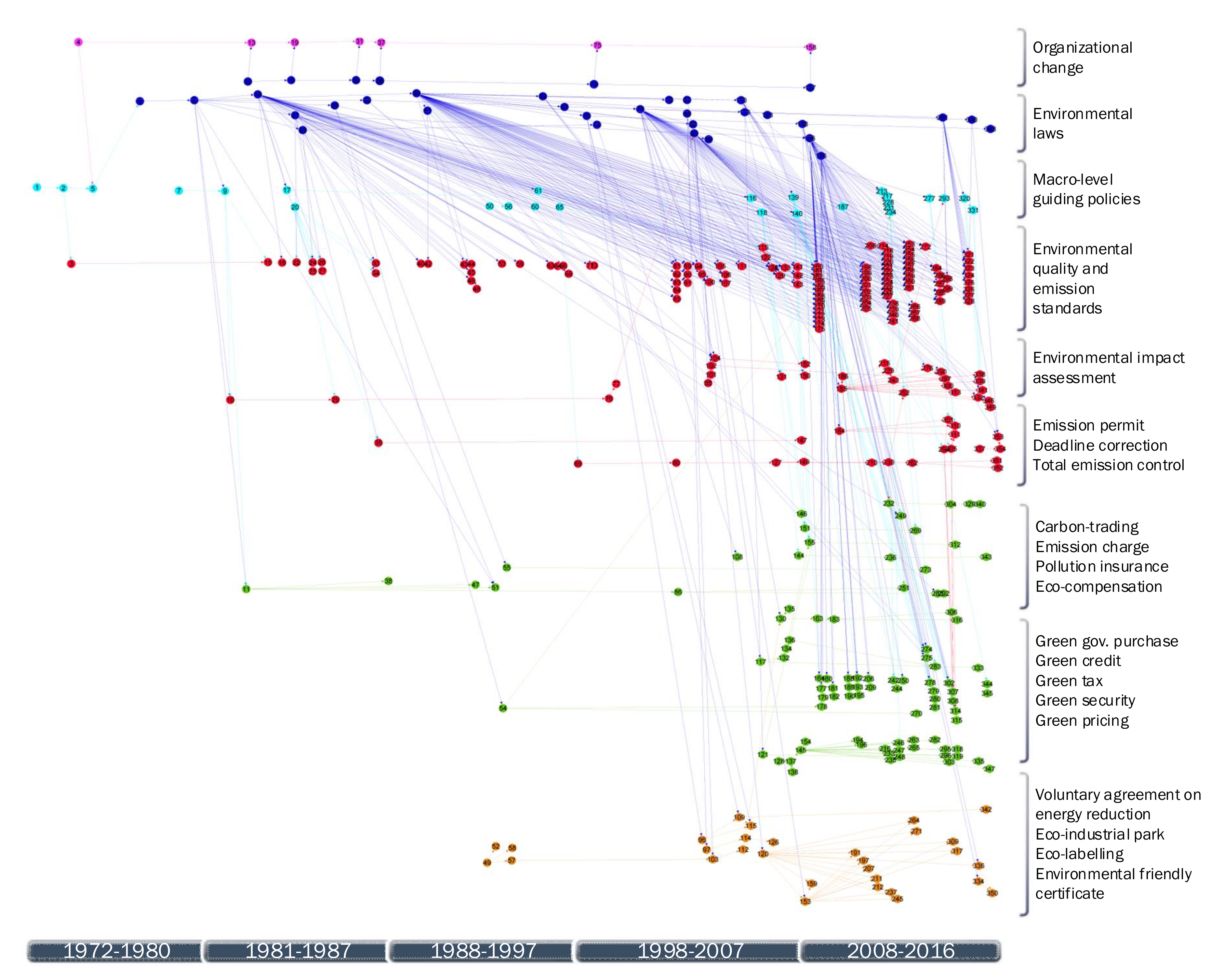
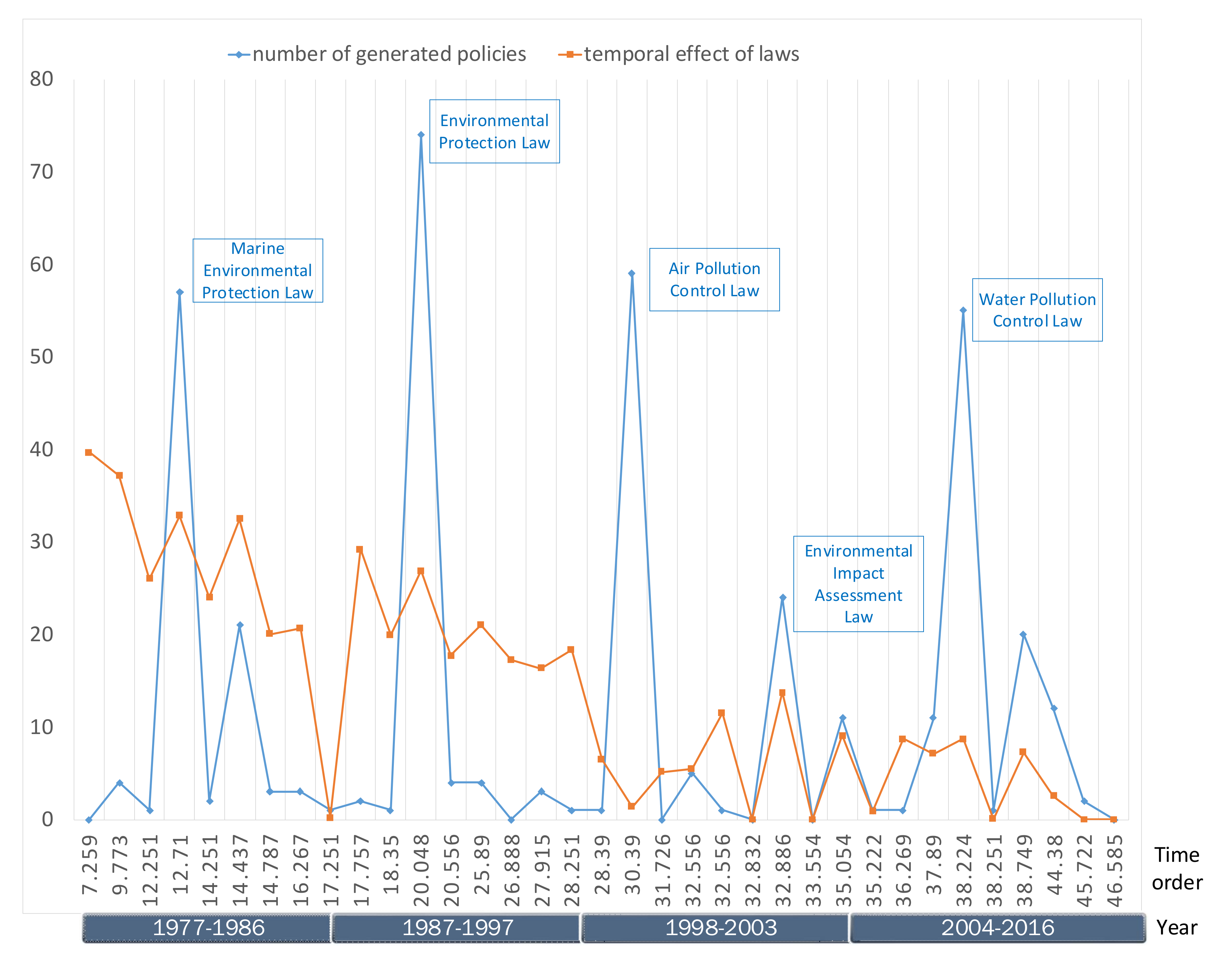
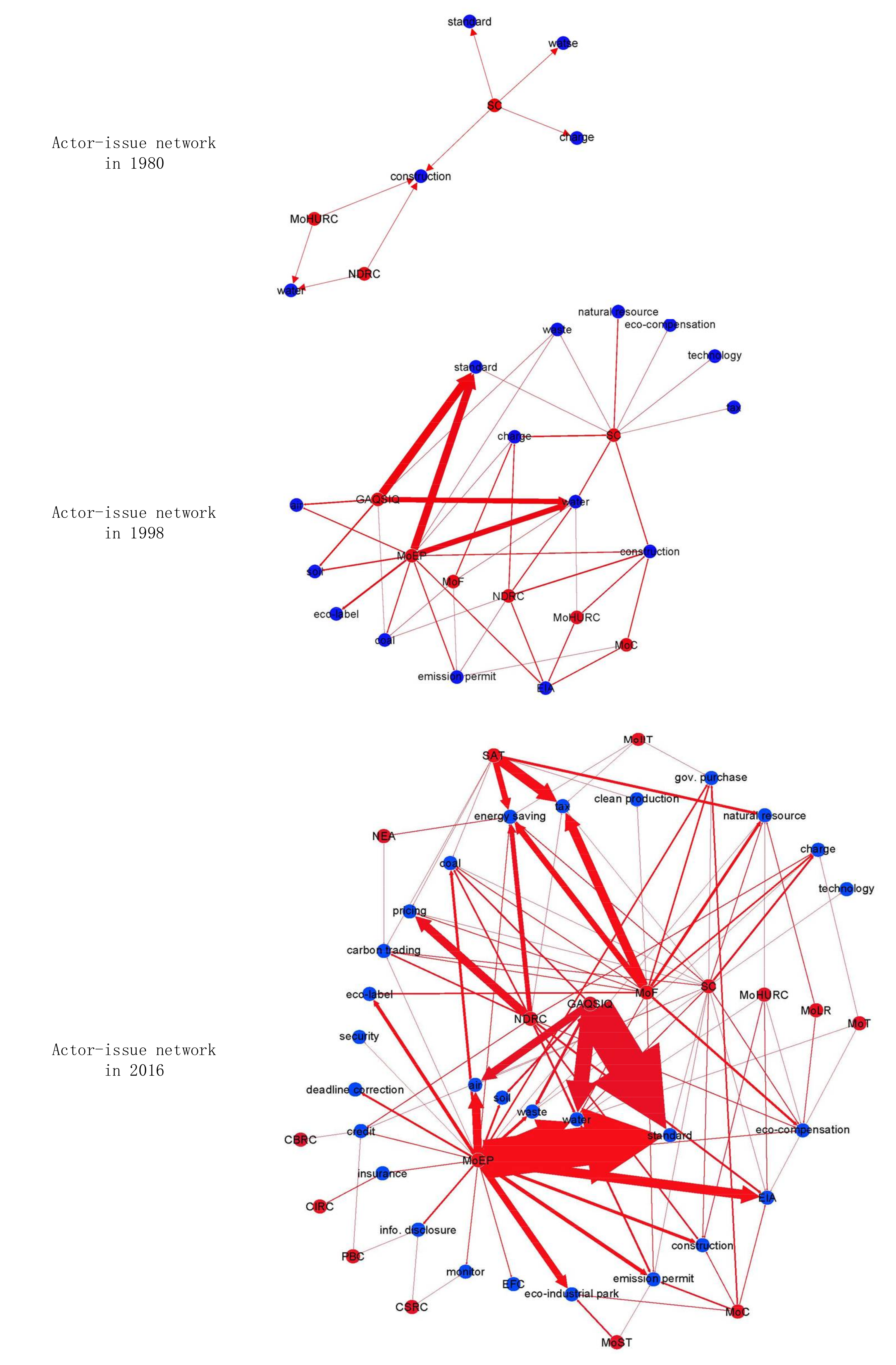
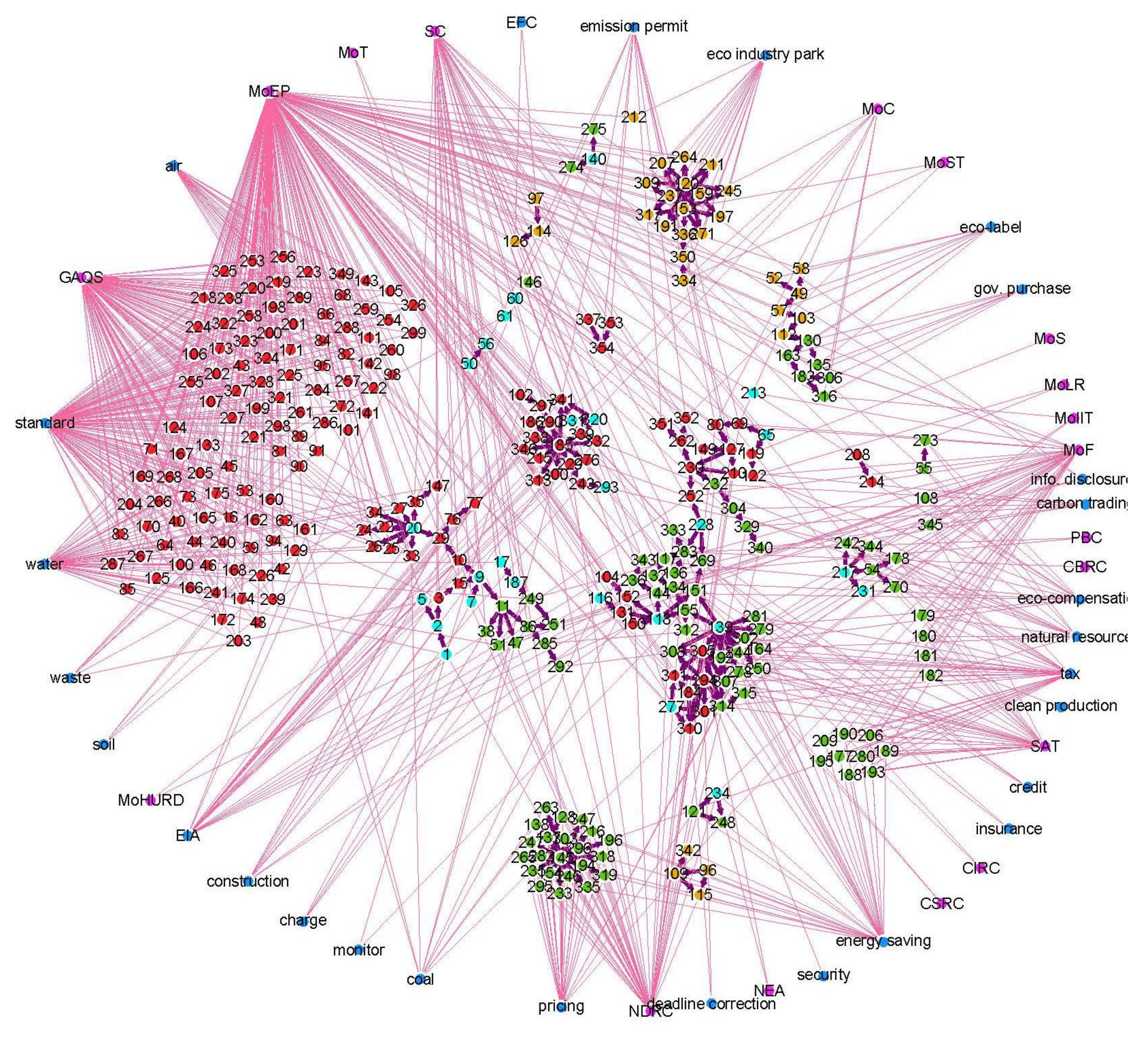
| Year | Name of Law |
|---|---|
| The socialist period (1972–1978) | |
| 1977 | The Constitution of China was amended by writing: “the State protects the environment and natural resources against pollution and other damage” |
| The economic reform period (1978–2000) | |
| 1979 | Environmental Protection Law (trial) |
| 1982 | Marine Environmental Protection Law |
| 1984 | Water Pollution Control Law |
| 1984 | Forest Law |
| 1986 | Mineral Resources Law |
| 1987 | Air Pollution Control Law |
| 1989 | Environmental Protection Law (formal) |
| 1990 | Soil and Water Conservation Law |
| 1995 | Solid Waste Pollution Prevention and Control Law |
| 1997 | Energy Conservation Law |
| 1998 | Forest Law (amendment) |
| The rapid economic growth period (since 2000) | |
| 2000 | Air Pollution Prevention and Control Law (amendment) |
| 2001 | Sand Control Law |
| 2002 | Government Purchasing Law, which stipulates that environmentally friendly products have priority in governmental purchasing |
| 2002 | Clean Production Promotion Law |
| 2002 | Water Law |
| 2002 | Environmental Impact Assessment Law |
| 2004 | Solid Waste Pollution Prevention and Control Law (amendment) |
| 2005 | Renewable Energy Law |
| 2007 | Energy Saving Law (amendment) |
| 2008 | Water Pollution Prevention and Control Law (amendment) |
| 2008 | Circular Economy Promotion Law |
| 2014 | Environmental Protection Law (amendment), which proposes the strictest environmental pollution standards |
| 2015 | Air Pollution Prevention and Control Law, which proposes the strictest air pollution standards |
| 2016 | Energy Saving Law (amendment) |
| Actor Name | Actor Responsibility |
|---|---|
| National People’s Congress (NPG) | Enacting environmental laws. |
| State Council (SC) | Formulating macro-level national development plans and environmental regulations and guidance. |
| Communist Party of China (CPC) | Setting environmental targets and controlling political personnel system in governmental organizations based on target performance. |
| National Development and Reform Commission (NDRC) | Setting the right price for industry operation, and reconciling goals of economic development and environmental protection. |
| Ministry of Environmental Protection (MoEP) | Preventing and controlling environmental pollution, protecting nature and ecology, safeguard environmental safety. |
| Ministry of Housing and Urban-Rural Construction (MoHURC) | Conducting environmental impact assessment for construction projects. |
| Ministry of Commerce (MoC) | Encouraging industries to innovate and apply environmental protection technologies, adopt cleaner production processes and promote green supply chain development. |
| Ministry of Industry and Information Technology (MoIIT) | Encouraging industries to innovate and apply environmental protection technologies, adopt cleaner production processes and promote green supply chain development. |
| Ministry of Science and Technology (MoST) | Encouraging industries to innovate and apply environmental protection technologies, adopt cleaner production processes and promote green supply chain development. |
| Ministry of Land and Resources (MoLR) | Resource protection and ecological compensation. |
| National Energy Administration (NEA) | Promoting energy-saving and the usage of renewable energies. |
| Ministry of Transport (MoT) | Reducing environmental pollution sourced from transportation and promoting new energy vehicles. |
| General Administration of Quality Supervision (GAQS) | Giving support to the MoEP for the formulation of environmental quality standards. |
| Inspection and Quarantine (GAQSIQ) | Giving support to the MoEP for the formulation of environmental quality standards. |
| Ministry of Finance (MoF) | Providing financial incentives to enterprises to adopt environmental friendly products and processes. |
| State Administration of Taxation (SAT) | Providing tax incentives to enterprises to adopt environmental friendly products and processes. |
| Ministry of Supervision (MoS) | Holding public officials accountable for environmental enforcement and sanction. |
| People’s Bank of China (PBC) | Providing financial incentives to enterprises, including green credit, green securities and environmental liability insurance. |
| China Banking Regulatory Commission (CBRC) | Providing financial incentives to enterprises, including green credit, green securities and environmental liability insurance. |
| China Securities Regulatory Commission (CSRC) | Providing financial incentives to enterprises, including green credit, green securities and environmental liability insurance. |
| China Insurance Regulatory Commission (CIRC) | Providing financial incentives to enterprises, including green credit, green securities and environmental liability insurance. |
| Research Questions | Analytical Approaches | Measurement Indicators | Indicative Patterns |
|---|---|---|---|
| How do environmental laws and policies evolve overtime? | Event graph | Qualitative description of an event; Directed edges between events. | The contents and sequence of the events indicate the evolutionary trajectory of environmental governance. |
| What is the role of law in generating policies? | Event graph | Out-degree of a node: number of following events, to which an event may lead. | The higher the out-degree of a node (e.g., a piece of law), the more powerful the law is in generating policies. |
| How do actors and issues evolve in environmental laws and policies overtime? | Two-mode network | Weight of an edge: frequency at which an actor deals with an issue. | The higher the frequency, an actor deals with an environmental issue more frequently. |
| What is the position of actors in environmental governance? | Two-mode network | Betweenness centrality: a node with higher betweenness centrality would have more control over the network, because more information will pass through that node. | The higher the betweenness centrality, the actor is more important in environmental governance. |
| How do environmental laws and policies are intentionally and emergently linked with one another? | Three-mode network | Number of intentional linkage (edge); Number of emergent linkage (edge); Qualitative description of an event. | The higher the number of emergent linkages, and the lower the number of intentional linkages, the environmental laws and policies are more fragmented. |
| Notes on the measurement indicators: After loading the event data, the Gephi software may calculate the values of the indicators by built-in algorithm:
| |||
| 1980 | 1998 | 2016 | ||||
|---|---|---|---|---|---|---|
| Name | Betweenness Centrality | Name | Betweenness Centrality | Name | Betweenness Centrality | |
| Top 5 most central actors | NDRC | 0 | MoEP | 1.333 | MoEP | 31.111 |
| SC | 0 | NDRC | 1.333 | NDRC | 9.028 | |
| MoHURC | 0 | SC | 1.333 | SC | 9.028 | |
| MoHURC | 1.333 | MoF | 3.472 | |||
| MoF | 1.333 | PBC | 1.250 | |||
| Top 5 most central issues | construction | 50 | water | 5.275 | water | 0.850 |
| water | 0 | construction | 5.275 | coal | 0.850 | |
| charge | 0 | charge | 5.275 | charge | 0.850 | |
| waste | 0 | waste | 5.275 | energy | 0.850 | |
| standard | 0 | standard | 5.275 | carbon-trading | 0.850 | |
| natural resource | 0.850 | |||||
| eco-compensation | 0.850 | |||||
| gov. purchase | 0.850 | |||||
© 2018 by the author. Licensee MDPI, Basel, Switzerland. This article is an open access article distributed under the terms and conditions of the Creative Commons Attribution (CC BY) license (http://creativecommons.org/licenses/by/4.0/).
Share and Cite
Mu, R. Role of Law, Position of Actor and Linkage of Policy in China’s National Environmental Governance System, 1972–2016. Sustainability 2018, 10, 1065. https://doi.org/10.3390/su10041065
Mu R. Role of Law, Position of Actor and Linkage of Policy in China’s National Environmental Governance System, 1972–2016. Sustainability. 2018; 10(4):1065. https://doi.org/10.3390/su10041065
Chicago/Turabian StyleMu, Rui. 2018. "Role of Law, Position of Actor and Linkage of Policy in China’s National Environmental Governance System, 1972–2016" Sustainability 10, no. 4: 1065. https://doi.org/10.3390/su10041065




